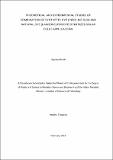| dc.description.abstract | Dye sensitized solar cells (DSSCs) convert visible sunlight to electricity using a wide band semiconductor. The DSSCs have attracted many researchers due to their environmental friendliness, low manufacturing cost and simple fabrication process. In the DSSCs, a sensitizer captures sunlight, injects electrons onto the semiconductor and becomes regenerated by electrolyte (redox mediator). Main challenges facing sensitizers relate to dye degradation, low efficiency, as well as high price and toxicity of some dyes. Co-sensitization of dyes which broaden the absorption spectrum of the sensitizer is among the different methods used to enhance the DSSCs efficiency.
In this work, the theoretical design of complex molecule (C45H32N2O4) through combination (esterification reaction) of the natural dye lawsone (C10H6O3) and synthetic metal free indoline dye D131 (C35H28N2O2) was performed. The molecular structures, vibration and electronic absorption spectra, excitation energies, and electron transitions of individual dyes and complex molecule were investigated using density functional theory (DFT) and time-dependent (TD-DFT) methods with B3LYP5 functional and 3-21G, 6-31G and 6-31G(d,p) basis sets. For the complex formation reaction, enthalpy, entropy and Gibbs free energy were calculated; the results predicted the reaction to be endothermic and non-spontaneous. Electron density distribution of the frontier and adjacent molecular orbitals and energy levels alignment were used for analysis of the electronic spectra and mechanism of transitions. The results indicated that the designed complex molecule satisfied the requirements for good photosensitizer for DSSCs.
The UV-Vis absorption spectra of the individual dyes and their mixture in chloroform solution were measured using spectrophotometer. The solution of the dyes mixture was prepared by combination of the 2.95×10–5 M indoline D131 and 1.15×10–4 M lawsone dye solutions in the ratio of 1:1. Generally despite the slight dissimilarities, the observed bands in the spectrum of the mixture corresponded to those of the individual dyes. Also DSSCs were fabricated using TiO2 electrode with active area of 36 mm2. The DSSCs’ performance was tested at outdoor conditions. The power conversion efficiency (PCE) of the DSSC with lawsone was 0.05%, indoline D131 2.8% and mixture of dyes 0.5%. Thus the PCE of the cell with natural dye was increased in ten times when the synthetic dye added. Combination of naural lawsone dye and indoline dye resulted into wider absorption range compared to those of the individual dyes. | en_US |

